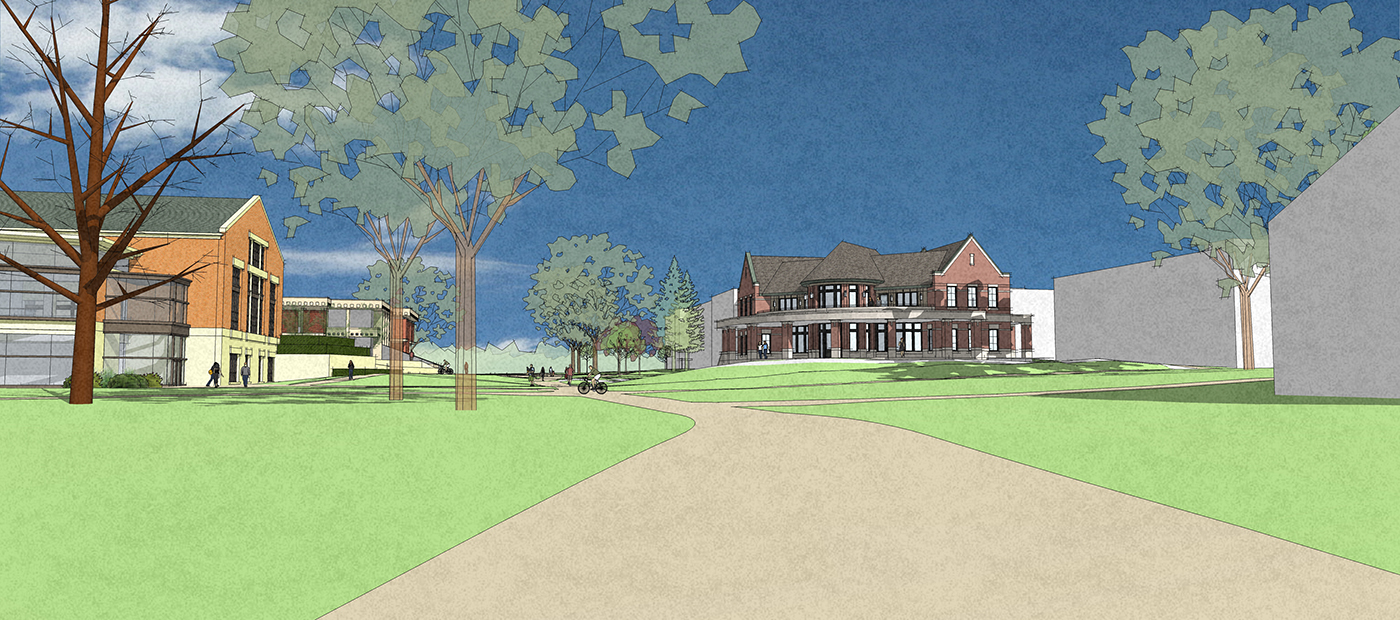Hope College will soon begin constructing a new home for its Campus Ministries program, a project headlining a three-component fundraising effort focused on supporting students’ faith formation.
The structure will be built in the central campus, along the former 12th Street between College and Columbia avenues, and between the Jim and Martie Bultman Student Center and Wyckoff Hall. Site preparation is underway and includes the removal of two college-owned homes at the location. Construction should begin this fall with completion anticipated for the fall of 2019.
The new building is part of the college’s “Faith Formation Initiative,” which is a
“micro campaign” that is also providing endowment support for a new chaplain in athletics
and for programming. The effort supports the college’s strategic plan, “Hope for
the World 2025,” which across multiple goals — from academics, to Christian formation,
to global engagement to community — emphasizes helping students engage with the Christian
faith and understand how it can inform them as they study, pursue vocation, and live
in community with others in a diverse and interconnected world.
“Working in partnership with the rest of campus, our ministry strives to share the Christian faith in a way that is ecumenically expansive, intellectually rich and missionally imaginative,” said the Rev. Dr. Trygve Johnson, who is the Hinga-Boersma Dean of the Chapel. “With the new space and resources, we’ll be better able to serve the college as Hope moves into a new future.”
The new center will succeed the Keppel House on 10th Street, a stately former private residence which has housed the program since 1994 but has become outgrown as Campus Ministries programming and student interest have expanded.
Designed to complement the surrounding campus architecture, the new, 11,000-square-foot building will include a covered porch facing Van Raalte Commons and the Pine Grove, with exterior greenspace for outdoor events or for students simply to enjoy fellowship and their surroundings. Within, the facility will include small and large gathering spaces, a commons area, a library that can also be used for meetings, a prayer alcove and office space sufficient for a staff that is currently spread among other locations.
“Space communicates what we value,” Johnson said. “At the center of campus we’re putting a building that’s dedicated to Christian formation and faith.”
The college is raising $6 million toward the project, which includes the site preparation, construction and an endowment for ongoing maintenance and building operations. Crucially, noted Jeff Puckett, vice president of development and alumni engagement, none of the funding was at the expense of other needs at the college.
“We completed the project with a committed group whose passion was to support this specific project within the Faith Formation Initiative,” he said. “In so many ways this effort complements our focus on growing the college’s endowment so that Hope can continue to offer an outstanding education at an affordable cost.”
To make way for the new building, the Delta Phi Cottage, a sorority house, was demolished on July 5 and 6, and the internationally themed Fried Cottage is scheduled to be moved to Columbia Avenue between 14th and 15th streets in August. Both the sorority and the internationally themed housing are being provided with other cottages on campus.
The athletics chaplaincy, funded with a $2 million endowment, will serve the approximately 500 students, more than 50 coaches as well as athletic training staff who are involved in athletics at the college, not only linking Campus Ministries and a major co-curricular program more closely but also providing pastoral care grounded in understanding of the students’ experience and sometimes-unique concerns. “What happens when a student blows out their knee and their career is over?” Johnson said. “There are a lot of issues of identity at play.”
The remaining $3 million being raised for endowment will help underwrite programming and some of the current staffing, so that the work does not result in a greater cost for families. “College-wide, we want to continue to offer world-class opportunities not only in the classroom but in co-curricular activities in a way that is affordable,” Johnson said. “We want to position the ministry so that it’s not tuition, room and board that’s funding it.”
The Campus Ministries program took its current form — a dean of the chapel leading a team of chaplains and additional staff — during 1993 and 1994, through an expansion funded by the college’s Hope in the Future comprehensive campaign, which included strengthening Christian life and witness as one of its four primary components. The college had previously had a chaplain and assistant chaplain whose offices were located on the lower level of Dimnent Memorial Chapel.
Architectural design for the new center is by AMDG Architects of Grand Rapids. The construction manager is Lakewood Construction of Holland.
